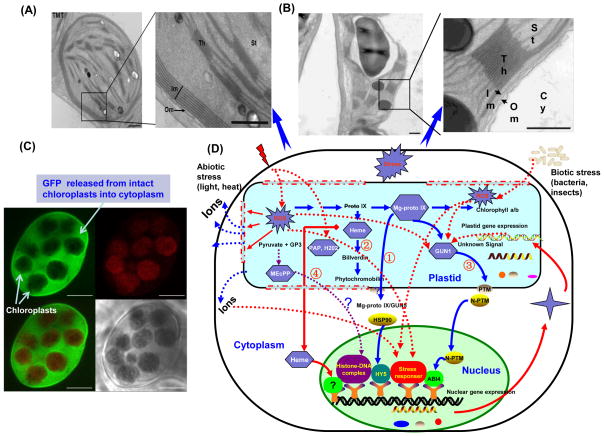Figure 4.
Chloroplast genome engineering facilitates study of retrograde signaling (A) Expression of gamma tocopherol methyl transferase via the chloroplast genome results in massive proliferation of the inner envelope membrane (up to eight layers) [55], very similar to 19 layers observed when inner membrane protein Tic40 was overexpressed [83]. While several inner membrane proteins encoded by the nuclear genome are upregulated, none of the outer membrane, stromal or thylakoid proteins are affected, suggesting specificity of retrograde signaling. (B) Note a single inner envelope membrane in control chloroplasts [55]. (C) Green florescent protein fused with an antimicrobial peptide (AMP) is released from intact chloroplasts when the leaf discs were infected with Erwinia carotovora and plant cells were imaged by confocal microscopy[for time lapse images of GFP-AMP, see reference 50]. Transient release of GFP-AMP triggered by Erwinia infection stops soon after conferring protection against the invading pathogen, further confirming protein export from chloroplasts. Light and paraquat stress modifies the structure of chloroplast envelope resulting in increased ion leakage and facilitates AMP release [50]. These results suggest novel retrograde signaling mechanisms, triggered by foreign proteins expressed in chloroplasts and offer new opportunities to study pathways outside chloroplasts (D) Proposed signaling mechanisms between plastid and nuclear genome are shown. ① Mg-protoporphyrin IX (Mg-Proto IX) pathway: Mg-Proto IX is an intermediate of tetrapyrrole pathway, which is suggested to be exported from chloroplasts to bind HSP90 in the cytoplasm, resulting in a HY5-dependent activated repression and/or inhibited activation of nuclear expression [86]; ② Heme, specifically produced by the plastid ferrochelatase (FC1) has been suggested to coordinate photosynthesis-associated nuclear gene expression with chloroplast development [109]; ③ Tetrapyrrole or other signals may work on Genome Uncoupled 1, which could either generate or transmit a second signal, thereby activating N-PTM protein. The processed PTM may modulate nuclear gene expression by inducing the ABA insensitive 4 transcription factor [86]; ④ MEcPP (methylerythritol cyclodiphosphate), a precursor of isoprenoids produced by the plastid methylerythritol phosphate (MEP) pathway, accumulates during stress. MEcPP destabilizes histone-like-DNA complexes in bacteria, suggesting a possible model for gene regulation [81]. The redox state of photosynthetic electron transport components of the plastids and the levels of reactive oxygen species (ROS) in plastids may be yet another candidate for retrograde signaling. ROS accumulated promptly when plants cells are exposed to stress. ROS alters the membrane structure and increases membrane penetrability, which is helpful for the transmission of signal molecules from plastids. More importantly, ROS may be directly involved in other retrograde signaling pathway such as MEcPP pathway as well as plastid gene expression pathway [50, 81].

